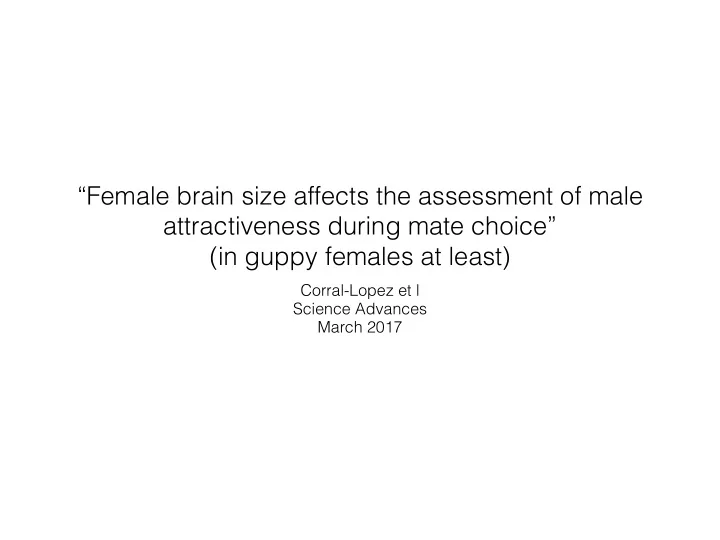

“Female brain size affects the assessment of male attractiveness during mate choice” (in guppy females at least) Corral-Lopez et l Science Advances March 2017
Question and experimental design two lines of females: large brain and small • brain previously shown to diverge in • cognitive abilities no differences in swimming • performance or condition index evidence for advantages of • small brains, such as better immune response, faster early juvenile growth, and higher fecundity . given option between attractive and • unattractive males(average wild type preferences)
Guppy mating behaviour and preferences • polyandry: females mate with multiple males. • female guppies delay the development of a brood when the anticipated second mate is more attractive than the first male • they prefer a novel male to the original male or a brother of the original male with similar phenotypes • what is an attractive male? • brightly coloured,larger tail; traits linked to fitness and foraging ability; • courtship behaviour: physical strength is needed in maintaining the courtship dance, called sigmoid display, in which the males flex their bodies into an S shape and vibrate rapidly. • social influence: females might copy other females’ preferences
https://www.youtube.com/watch?v=HOnCobaIZng
Results measure preference by time spent • near the attractive vs unattractive male large brain and wild types prefer • attractive males small brain indifferent (as a group) • BUT • equal times spent in viewing • areas equal levels of partner • preference(distributed indifferently between attractive and unattractive males for small brain lines) equal time spent out of choice • areas
• no difference in colour perception • no difference in opsin expression
Conclusions differences in mate preference cannot be explained by • differences in perceptual abilities • differences in motivation • difference in search strategy • previous experience (all females had been raised similarly; isolated • from males prior to the experiment) cognitive constraints: • females could not see both males simultaneously •
Recommend
More recommend